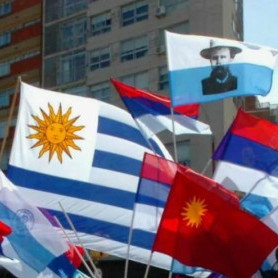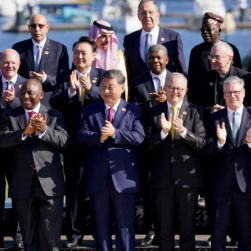Karadzic fulfilled all conditions. Yet he has been arrested. The original copy of the pact is allegedly stored in the Serbian Ministry of Foreign Affairs. The duplicate copies have been distributed to the Hague Tribunal and certain Serbian newspapers. Former high-ranking Yugoslavian Interior Ministry official Vlado Nadezdin confirmed authenticity of the pact, which he allegedly saw with his own eyes.
Holbrooke response to the Karadzic’s statement was very hard and rather predictable: “I negotiated a very tough deal. He (Karadzic – author’s note) had to step down immediately from his posts as president of the Serb part of Bosnia and as head of his party. And he did so… But when he disappeared, he put out a piece of disinformation that I had cut a deal with him if he disappeared we wouldn’t pursue him. That was a completely false statement“. Moreover Holbrooke said that he insisted on the arrest of Karadzic as far back as 1995: “He should have been arrested. His green Mercedes was parked in its parking spot outside his office for six months after (the 1995 Dayton peace agreement) each day. The NATO commander at the time refused to arrest him even though he had the authority to do so. It was a terrible mistake.”
Let’s leave all this emotional rhetoric on Mr. Holbrooke’s head. What else can he say just now? And in general all these statements on a secret deal and today’s claims of Karadzic leave a nasty taste in the mouth.
One thing is clear: Karadzic’s withdrawal from the political life in 1996 had abvious negative consequences for Yugoslavia and later for Serbia, and all the more for Serbian expat communities in Croatia, Bosnia and Herzegovina and Kosovo. Politicians of such rank have no right, choose my words carefully, to conclude “a separate collusion”, sorry, but it is impossible to find other words for his pact with the Devil. During the passed thirteen years Serbian minorities in fact had no leader that undoubtedly undermined their positions. Weakening of the Serbian factor made it possible in general to play the Kosovo scenario, split Monte Negro off Serbia, and bring rather disputable politicians to power in Serbia itself. When all conditions have been fulfilled, the Devil terminated his pact with Karadzic and just surrendered him. And what else did Karadzic expect? What morality may he appeal for today whereas his pact with Holbrooke itself was amoral?
Well then, “his example is a good lesson for others”. But let’s stick to the subject.
In the American foreign policy various enticements, promises and even swears easily get along with hardline pragmatic approach, lack of principles and mental cruelty. “Nothing personal – just business” – this phrase seems the best description of United States relationships with its partners both far and close. Therefore Russia understands well that any arrangements and agreements with the American side should be treated very discreetly.
Of course, nobody wants even to cast some suspicion about negotiability of the United States. So far.
Nevertheless the latest developments associated with the ABM, CFE and SALT treaties give grounds to concern. The demonstrative example of the US ability to keep the word is its promises given in the late 80s-early 90s not to expand NATO eastwards and respect Russia’s national interests in the post-Soviet area.
However practically as soon as the USSR left Eastern Europe the United States started espanding its sphere of influence eastwards both by enlarging NATO and by overthrowing governments loyal to Russia in former Soviet republics by using a so-called “color revolution” technology.
The successful “color revolutions” in Ukraine and Georgia evidently became for the United States not only a successful ad-lib but also an incentive to launch a large-scale programme aimed at removal of Russia as an influential center of force off the political map of the world.
In fact, the “color revolution” is the same “pact with the Devil” offered to an actual head of state that calls for him to accept the American terms and conditions in order to get an illusive US support otherwise this head of state will be removed in the broad sense of the word by using a package of political technologies. Nevertheless later this head of state will be definitely replaced with a politician from the American own political puppet theater. The third option does not exist.
But this is strategy and tactics. What are the instruments for their implementation?
Today it became clear that key instruments for preparation of the “prerevolutionary situation” are specific non-governmental organizations (NGOs) funded from overseas. The mission of these NGOs is to loosen, warm up and canalize the public opinion inside the country. Meanwhile any attempts of the state to suppress such activities encounter pre-prepared propaganda campaign about the infringement of fundamental human rights and liberties, about strengthening of the authoritarian rule and suppression of the democracy. Therefore the struggle against these NGOs requires sufficient political courage.
For a long time, the American political tool kit lacked an instrument for actual implementation of the revolution and post-revolutionary transformations. Meanwhile without this instrument, as the practice of recent years shows, “the color revolution” is ether suppressed, or dies out or gets out of hand of the wire-puller.
It seems that the United States started designing such instrument long ago. In the 90s it was the United States Agency for International Development (USAID) that borne the main burden of strategic subversive actions in particular in the Russian Federation. It is logical that its staff occupied an entire module in the new territory of the US Embassy in Moscow. According to Janine R. Wedel, as associate research professor in the Institute of European, Russian and Eurasian Studies at the George Washington University (USA), in the 90s the US State Department created via the USAID in Russia a network of “quazi-private organizations” “that had a chameleon-like quality” and were directly involved in efforts to deteriorate the Russian economy competitiveness, liquidate its full industries under the pretext of restructuring and impose cul-de-sac quazi-economic theories.
Among these organization Wedel focuses on State-Public Fund Russian Privatization Center (RPC), which was 100-% funded from a special USAID grant and had a massive influence on the Russian Federal Property Fund, Federal Commission on Securities and the Capital Market and Russian Ministry of Finance. Another organization of the same quality was the Institute of Law-Based Economy (ILBE), which was registered with the Russian Government as a nonprofit, noncommercial entity in 1995. According to Wedel, for the beginning the ILBE received 20 million Dollars from the USAID as a grant via the Harvard Institute for International Development (HIID). Later the main donor of the ILBE was the World Bank. This organization funded from the American resources “has drafted a lot of legislation and degrees for the Russian Government”. “Like the RPC and ILBE the Resource Secretariat, another USAID-funded organization (with some support from other donors) was set up… The Resource Secretariat was to provide “intellectual capital” to the Federal Commission on Securities and the Capital Market (and coordinate USAUD-funded contractors providing it).”
However, it seems that the capabilities of the USAID only were not enough to keep the social and economic processes in Russia of the late 90s in the direction canalized by the Americans. So, by the end of the XX century the work of the aforesaid “quazi-private” organizations was partially or completely winded down, at least in the form they were set up by our American partners initially.
This experience in Russia and certain other post-Soviet republics was learnt by the Americans well enough.
On July 16, 2008 a solemn ceremony of launching a new project, the Civilian Response Corps (CRC), was held in the US Department of State. The CRC is an interagency body established by the Department of State, US Agency for International Development (USAID), Departments of Agriculture, Commerce, Health and Human Services, Homeland Security, Justice, and Treasury. The Department of State is to coordinate the activities of the Corps. Actually the Corps will operate under supervision of John Herbst, the Coordinator for the Office of Reconstruction and Stabilization (S/CRS) in the US State Department (former US Ambassador to Uzbekistan – author’s note). If we keep aside all fancy dress the main task of the Corps is to provide for practical implementation of “the color revolution”, utilize and secure its practical outcome. The CRC in fact is a key structured and aligned mechanism rather that the instrument of “the color revolution” first of all in the post-Soviet area and if possible in Russia.
The Corps consists of 250 full-time members of the Active component. They are highly skilled professionals - diplomats, government and city administrators, public health officials, law enforcement and corrections officers, engineers, economists, lawyers, public administrators, agronomists, port operators, etc. They are capable of rendering necessary high-quality services to local administrations and even replace them in need and provide for “whole of government” work. All of them will undergo special training and will be properly equipped. In addition to the Active component the Corps will have a “Standby” component of 200 professionals of the same skills and “Reserve” component of additional 2000 persons. They are volunteers from the private sector and state and local governments, who are ready like the “active” members to be deployed to any place on the globe for an agreed term. The US Congress already provided up to $75 million in initial funding for the Active and Standby components of the Civilian Response Corps.
It is noteworthy that the agencies that established the Corps include neither the CIA, nor the NSA, nor the FBI, nor the DIA, nor any other accustomed agencies of the US Intelligence Community. It is quite understandable and logical. These agencies would only discredit the Corps while in the actual configuration “it is beyond any suspicions as Caesar’s wife”. Indeed, for example, in the aircraft-building company it is not the security officers who design and build the aircraft engaging the designers and engineers in need but it is the designers and engineers who engage the security officers in need. As for the power and information support, these 4250 professions will be any minute provided with anything then need including, say, an aircraft-carrier task force.
And finally…
Today our country, our friends and allies will have to encounter a new very dangerous and perhaps effective force, a cancer of the XXI century – “the color revolutions”. It is evident that only traditional countermeasures against the subversive activities of “color revolutionaries” will not be enough. Perhaps it would be necessary to create not less effective comprehensive mechanism of adequate response providing for “pro-active” defense of our national interests both in the post-Soviet area and in all areas of the world strategically important to Russia. It seems that to this end it would be wise to use not only our own experience and achievements but also the useful experience of our overseas partners.
Oh, God, Russia is sick and tired of all and any revolutionaries…









